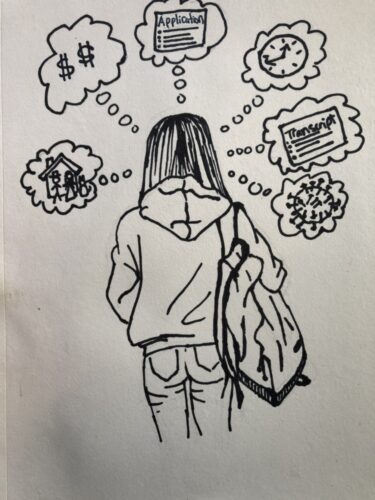Pandemic Adds Ripples to Turbulent Transfer Tides
By Deena Sabra
Collaborator to The Guardsman
The number of community college students transferring to four-year universities continues to decline, despite recent data that shows a slight increase during the COVID-19 outbreak in 2020.
The decline has been experienced locally at City College and has been declining steadily in the last five years, according to City College Banner and National Student Clearinghouse.
The data shows that there were 2,138 transfers in the 2014-15 school year, declining to 1,888 in the 2015-16 school year, and down again to 1,681 during 2016-17. The numbers stayed approximately the same, in 2017-18 with 1,606, but dropped in the 2018-19 school year to 1,595.

Despite their best intentions, many of California’s two million community college students aren’t able to take or pass enough courses to make headway.
Roughly 900,000 students fell into this category between 2010 and 2015. However, according to the Research and Planning Group, a surprising number of California’s community college students, about 300,000 during this period, had met the requirements for transfer or were just a course away from doing so and still didn’t end up transferring.
The RP Group surveyed 800 California community college students and interviewed
others in depth to understand why some students managed to transfer and others didn’t.
Some of the reasons cited for this were lack of money and knowledge of available financial aid, balancing family with school schedules, meeting requirements and following procedure, the complicated transfer process itself, and a lack of support from a caring adult or support network.
Remedial classes and math anxiety were additional transfer setbacks noted by the Hechinger Report.
Nationally, there has also been a general drop in transfer rates from two-year community colleges to four-year universities, particularly in the last 10 years. According to the National Student Clearinghouse Research Center, only 13% of the students who start at community college manage to get a bachelor’s degree six years later.
One part of the problem is that only 30% of community college students succeed in transferring
to a four-year institution.
One issue causing the logjam is the red tape involved in transferring. Lost college credits continue to derail hundreds of thousands of transfer students nationally, especially for the disproportionately low-income, first generation, and racial and ethnic minority students who begin their education at community colleges.
Students who transfer lose 43% of the credits they’ve earned, according to the U.S. Government Accountability Office. Even when the credits are accepted, they don’t often count towards a major.
In California, steps are being taken that help community college students avoid momentum-killing remedial courses by taking into account other measures of academic readiness. This could increase the number of students qualified to transfer to four-year universities by as much as 50%, according to the Public Policy Institute of California.
California has begun leveraging its Cal Grants financial aid program to pressure private colleges to take community college credits in the same way public institutions do.
In August, San Francisco State University (SFSU) and City College announced a new partnership to foster transfer pathways by leveraging existing California State University policies regarding lower-division transfers that expand transfer opportunities to include freshman and sophomore students from the California Community College system. This will allow community college students to transfer to SFSU earlier in their educational careers, which is shown to greatly increase educational outcomes.
City College alumnus Amanda Dial, has just successfully transferred to a four-year university. Dial has attended City College for the last three years having transferred colleges several times before, once from the University of San Francisco (USF), where she spent a year and a half with the goal of pursuing a nursing career, and then from Laney College.
Although Dial says she did not experience many obstacles at City College, her
experience with the transfer process was not without its issues. While taking a career
development class, Dial spoke with a counseling professor who discovered she had more
credits than she had reported. While at USF, Dial had taken Biology and Science classes
towards her nursing goal. However, after changing her major to English, she felt these credits weren’t necessary to report because they were not relevant to her newly chosen major. She also did not want her past to ruin her current 4.0 grade point average (GPA).
Her counselor helped Dial realize that, not only were these credits not going to negatively
affect her GPA because colleges would be looking at her most recent grades, but that with
those previously unreported credits, she was only a semester away from having the units she
needed for transfer. Without those unreported credits, she could have potentially spent several more semesters and more money before transferring, not to mention potentially being in trouble for not reporting those courses.
The COVID-19 pandemic has caused confusion and created unique new obstacles for
those looking to transfer due to mandated stay-at-home orders, newly implemented remote
learning and closed campuses.
In Dial’s case, Spring 2020 was supposed to be her last semester at City College and she had planned to transfer to San Francisco State University in the Fall. Because of COVID-19 and shutdowns, “… I lost a bit of momentum,” Dial said.
She said she had less motivation from the lack of structure and inertia this year has brought, and that the lack of physical classes didn’t not help. “It did make it a bit more difficult.”
Dial also changed her destination plans due to COVID-19. Instead of transferring to San Francisco State University, she decided to go to City College. Though COVID-19 did delay her by a semester, Dial successfully completed her transfer requirements the following Fall semester and will begin Spring 2021 at California State University Long Beach.
